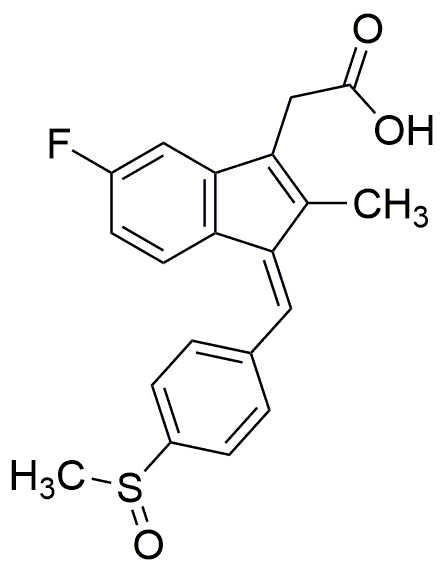Sulindac is widely utilized in research focused on:
- Pain Management: Commonly used as a non-steroidal anti-inflammatory drug (NSAID), it effectively alleviates pain and inflammation, making it valuable in treating conditions like arthritis.
- Cancer Research: Studies have shown that Sulindac may have chemopreventive properties, particularly in colorectal cancer, providing a potential avenue for researchers exploring cancer therapies.
- Cardiovascular Health: Its anti-inflammatory properties can be beneficial in managing cardiovascular diseases, offering a dual approach to pain relief and heart health.
- Veterinary Medicine: Sulindac is also used in veterinary applications for pain relief in animals, showcasing its versatility across species.
- Drug Formulation: The compound's unique properties allow for the development of various formulations, enhancing patient compliance and treatment outcomes.
General Information
Properties
Safety and Regulations
Applications
Sulindac is widely utilized in research focused on:
- Pain Management: Commonly used as a non-steroidal anti-inflammatory drug (NSAID), it effectively alleviates pain and inflammation, making it valuable in treating conditions like arthritis.
- Cancer Research: Studies have shown that Sulindac may have chemopreventive properties, particularly in colorectal cancer, providing a potential avenue for researchers exploring cancer therapies.
- Cardiovascular Health: Its anti-inflammatory properties can be beneficial in managing cardiovascular diseases, offering a dual approach to pain relief and heart health.
- Veterinary Medicine: Sulindac is also used in veterinary applications for pain relief in animals, showcasing its versatility across species.
- Drug Formulation: The compound's unique properties allow for the development of various formulations, enhancing patient compliance and treatment outcomes.
Documents
Safety Data Sheets (SDS)
The SDS provides comprehensive safety information on handling, storage, and disposal of the product.
Product Specification (PS)
The PS provides a comprehensive breakdown of the product’s properties, including chemical composition, physical state, purity, and storage requirements. It also details acceptable quality ranges and the product's intended applications.
Certificates of Analysis (COA)
Search for Certificates of Analysis (COA) by entering the products Lot Number. Lot and Batch Numbers can be found on a product’s label following the words ‘Lot’ or ‘Batch’.
*Catalog Number
*Lot Number
Certificates Of Origin (COO)
This COO confirms the country where the product was manufactured, and also details the materials and components used in it and whether it is derived from natural, synthetic, or other specific sources. This certificate may be required for customs, trade, and regulatory compliance.
*Catalog Number
*Lot Number
Safety Data Sheets (SDS)
The SDS provides comprehensive safety information on handling, storage, and disposal of the product.
DownloadProduct Specification (PS)
The PS provides a comprehensive breakdown of the product’s properties, including chemical composition, physical state, purity, and storage requirements. It also details acceptable quality ranges and the product's intended applications.
DownloadCertificates of Analysis (COA)
Search for Certificates of Analysis (COA) by entering the products Lot Number. Lot and Batch Numbers can be found on a product’s label following the words ‘Lot’ or ‘Batch’.
*Catalog Number
*Lot Number
Certificates Of Origin (COO)
This COO confirms the country where the product was manufactured, and also details the materials and components used in it and whether it is derived from natural, synthetic, or other specific sources. This certificate may be required for customs, trade, and regulatory compliance.


